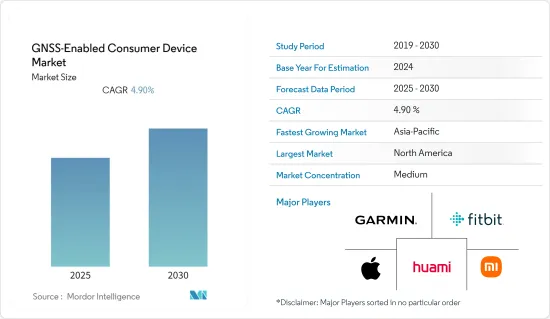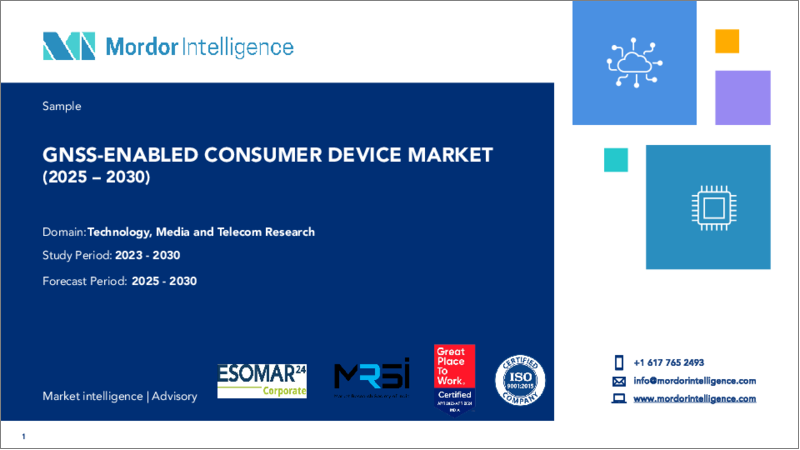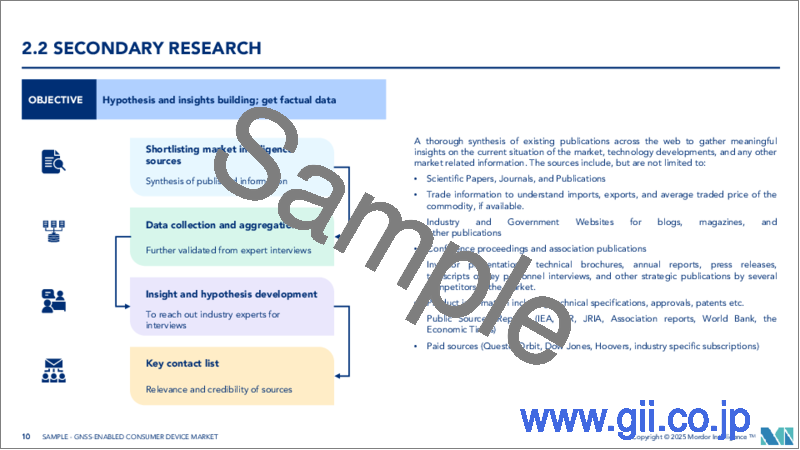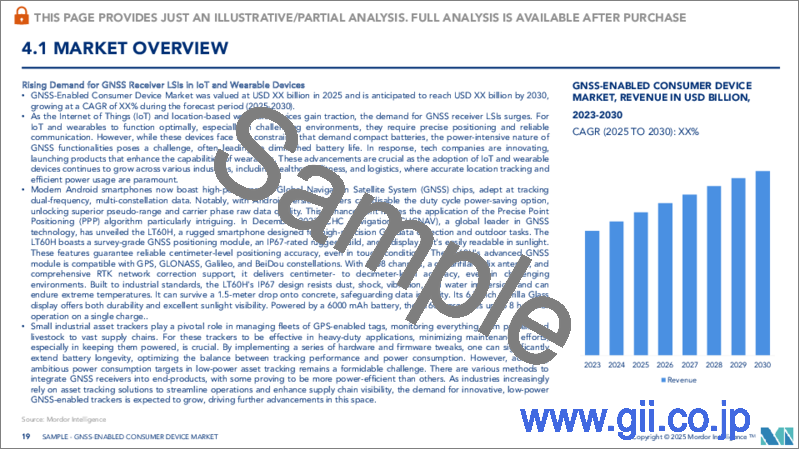|
|
市場調査レポート
商品コード
1644655
GNSS対応コンシューマデバイス:市場シェア分析、産業動向・統計、成長予測(2025年~2030年)GNSS-Enabled Consumer Device - Market Share Analysis, Industry Trends & Statistics, Growth Forecasts (2025 - 2030) |
||||||
カスタマイズ可能
適宜更新あり
|
|||||||
| GNSS対応コンシューマデバイス:市場シェア分析、産業動向・統計、成長予測(2025年~2030年) |
|
出版日: 2025年01月05日
発行: Mordor Intelligence
ページ情報: 英文 120 Pages
納期: 2~3営業日
|
全表示
- 概要
- 目次
GNSS対応コンシューマデバイス市場は予測期間中に4.9%のCAGRで推移する見込みです。

モノのインターネット(IoT)や位置情報を利用するウェアラブルデバイスの普及が進み、GNSS受信LSIの需要が高まっています。IoTやウェアラブルデバイスは、通信環境が厳しく不安定な状況でも使用されるため、正確な測位と信頼性の高い通信を確保する必要があります。また、機器サイズの制約からバッテリーを小型化する必要がありますが、GNSS機能を利用した衛星信号の受信や測位には多くの電力を消費するため、バッテリーの持ちが悪くなります。そのため、さまざまなテクノロジー企業がウェアラブル端末の機能を強化する新製品を開発・発売しています。
さらに、新世代のアンドロイド・スマートフォンには、2周波マルチコンステレーション・データを追跡できる高性能な全地球衛星測位システム(GNSS)チップが搭載されています。さらに、アンドロイドのバージョン9から、ユーザーはデューティ・サイクルの省電力オプションを無効にすることができるようになり、より高品質の擬似距離と搬送波位相の生データが利用できるようになりました。また、PPP(Precise Point Positioning)アルゴリズムの適用がより興味深いものとなっています。この研究は、Broadcom BCM47755を搭載したXiaomi初の2周波GNSSスマートフォンのPPP性能を評価することを目的としています。Xiaomiが取得した性能を単一周波数のスマートフォンであるSamsung S8と比較することで、2周波データを取得する利点が強調されます。シャオミが達成した垂直方向の精度は0.51m、水平方向の精度は6mであるのに対し、サムスンが達成した精度は水平・垂直ともに15mで5.64mです。
産業用資産追跡アプリケーションで使用される小型の産業用資産トラッカーは、小包、箱、ロールケージ、家畜、および広大なサプライチェーン全体のチェックを維持するために、GPS対応の資産タグの大規模な艦隊を管理するために設計されています。これらは、主にトラッカーの電源を維持することに焦点を当てたメンテナンスの努力が最小限に保たれている場合にのみ、重いアプリケーションで実行可能になる可能性があります。トラッキング性能と消費電力の比率を最適化するために、一連のハードウェアおよびファームウェアベースの微調整を使用することによって、バッテリーの寿命を大幅に延ばすことができます。しかし、低消費電力の資産追跡や関連アプリケーションにおいて、野心的な消費電力目標を達成することは難しい課題です。GNSS受信機を最終製品に統合する方法は数多くあり、その中には他の方法よりも電力効率の高いものもあります。
2022年2月、コロラド州を拠点とするDronee社は、GNSSサポートと長距離低電力LoRa無線アップリンクを組み合わせた設計で、1回の充電で最大1年間の追跡が可能なオープンソースの資産追跡装置「Loko」の発売準備を進めていると発表しました。このデバイスの特長はバッテリー寿命が長いことで、位置の送信頻度にもよるが、内蔵バッテリーの1回の充電で30日から1年以上動作します。
COVID-19のおかげで複数の新しいアプリケーションが生まれ、GNSSチップの利用が増えました。例えば、COVID-19はサプライチェーンの資産を正確に輸送し追跡する必要性を高めました。GNSSの効果的な利用は、検疫の監視と執行に使われており、ジオフェンシングとして知られるプロセスを通じて、自己検疫対象者の仮想境界線を設定するのに使われています。一般的に、位置データはスマートフォンやその他のサポートデバイスから収集され、自己検疫が破られたときに地元当局に通知するために利用されます。
GNSS対応コンシューマデバイス市場の動向
スマートフォン・セグメントが市場の成長を大きく牽引する見込み
EU28、北米、中国などの成熟市場ではスマートフォンがかなり飽和しているにもかかわらず、スマートフォンの出荷台数はGNSSチップを使ったデバイスの出荷台数をまだ上回っています。スマートフォンはかなり以前からGNSSチップを使用しています。ほとんどの場合、これらのチップはGPS、GLONASS、Galileoなど、一般に利用可能なすべての衛星ネットワークをサポートしています。しかし、専用のナビゲーション・デバイスと比較すると、これらのソリューションは精度が低かった。
さらに、スマートフォンのハードウェア市場では、ある程度の独占状態がGNSSチップの搭載範囲を制限していました。クアルコムのハードウェアは通常、ブロードコムのGNSSチップを搭載しておらず、またその逆も同様です。しかし近年、このシナリオは変わりつつあります。さらに、欧州委員会は、市場に投入される新しいスマートフォンに衛星およびWi-fi位置情報サービスを含めることを義務付ける規制を承認しました。この規制によると、全地球衛星測位システム(GNSS)機能を搭載したチップセットは、正確な位置情報とタイミング情報を提供するEUの衛星システム「ガリレオ」にアクセスできるようになるようです。EUの8カ国はこの規制に従い、ガリレオ対応チップセットを使用しています。
欧州GNSS庁によると、ブロードコム、クアルコム、メディアテックといったスマートフォン用チップセットの各種メーカーを含め、衛星ナビゲーション・チップセット供給市場の95%以上が新製品でガリレオをサポートしています。主要なGNSSチップセット・プロバイダーがGalileoチップセットを製造し、世界のスマートフォン・ブランドが既にこれらのチップセットを最新のスマートフォン・モデルに組み込んでいることから、市場は予測期間中に更なる成長機会を得ることが期待されます。
さらにグーグルによると、都市部では歩行者のスマートフォンから1日当たり10億件以上の修正が行われ、通りの反対側や街区を間違えているといいます。2021年、ブロードコムは、ブロードコムの2周波 GNSS BCM47765チップと、同社の3D建物モデルを使用した複雑なGNSS反射光線モデリングによってGNSS支援を提供する新しいAndroidサービスを組み合わせることで、正確な歩行ナビゲーションを大幅に改善する新しいソリューションを発表しました。
Android 7.0のリリース以来、Androidで動作するスマートフォンで追跡された生のGNSS測定値にアクセスできます。これらのGNSS観測は、特別に自己開発されたアルゴリズムと補正データを使用して、ユーザーの位置を推定するために直接使用することができます。スマートフォンはシンプルで費用対効果の高いGNSSチップとアンテナを搭載しているため、課題である低品質の測定値を提供します。さらに、ほとんどのスマートフォンは、1つの周波数のGNSS測定しか提供していません。
精密点測位(PPP)は、全地球航法衛星システム(GNSS)データの最も有望な処理技術の1つです。この技術の特徴は、正確な衛星プロダクト(軌道、クロック、バイアス)を使用し、高度なアルゴリズムを適用してユーザーの位置を推定することです。相対測位法とは対照的に、PPPは近隣の基準局や地域の基準ネットワークに依存しません。さらに、PPPは非常に柔軟であり、スマートフォンの(単一周波数の)GNSS測定の課題を考慮すると、これも利点となります。
高い市場成長が期待されるアジア太平洋地域
2021年3月、中国は第14次5カ年計画を発表しました。この計画は、今後5年間の開発のあらゆる側面に触れ、中国の2035年ビジョンを示すものです。第14次5カ年計画では、R&Dとイノベーションを重視しており、中国のGNSS産業に大きな影響を与えています。「BeiDousシステムの普及と利用の深化、業界の高品質な成長の促進」は、重要な国家戦略プロジェクトとして計画の政策指針として提唱されています。この戦略は、GNSS産業の研究開発を後押しし、BeiDouの産業応用を促進し、重要なコア技術の進歩を加速することを意味すると期待されています。
中国GNSS・LBS協会(GLAC)は2021年5月18日、北京で2020年のGNSS産業の発展をまとめた「中国衛星測位・位置情報サービス産業開発白書(2021年版)」を発表しました。白書によると、中国の衛星ナビゲーション・位置情報サービス事業全体の生産額は2020年に4,033億人民元(約627億5,000万米ドル)に達し、2019年から16.9%増加しました。
この地域の企業は、顧客の幅広いニーズに応えるため、既存製品に新機能を取り入れたり、新製品を開発したりしています。例えば、2022年4月、ComNavTechnology社によってP300シリーズGNSSタブレットが世界市場に提供されました。K8プラットフォームをベースとした高精度GNSS車載Android堅牢タブレットは、精密農業、自律走行、機械制御、その他の業界に業界をリードする極めて優れた性能と使いやすさを提供します。新世代のK8 OEMモジュールを搭載したP300シリーズGNSSタブレットは、現在および計画されているすべての星座(GPS、BeiDou、BeiDouGlobal、GLONASS、Galileo、QZSSを含む)を追跡し、センチメートルレベルの精度を達成することができます。P300シリーズGNSSタブレットは、高度なQUANTUMTM IIIテクノロジーと、アップグレードされたSinoGNSSASICチップおよび高度なマイクロプロセッサー・ユニットを採用し、日常的な現場での使用に適した、より優れた方位と測位の性能を提供します。
さらに2021年12月、メディアテックは、OPPO、Vivo、Xiaomi、Honorを含む世界有数のスマートフォンブランドから、次世代フラッグシップスマートフォン向け5Gスマートフォンチップ「Dimensity9000」がデバイスメーカーに採用され、エンドースメントを受けたことを発表しました。Dimensity9000を搭載した最初のフラッグシップスマートフォンは、2022年第1四半期に市場に登場する予定です。このプロセッサーは最新のWi-Fi、Bluetooth、GNSS規格をサポートしているため、スマートフォンユーザーはシームレスな通信を体験できます。
情報技術と携帯電話技術の導入以来、各国はPVTベースのアプリケーションに大きく依存してきました。現在、世界では4つのGNSSシステムが利用可能である:米国のGPS、ロシアのGLONASS、欧州連合のGalileo、中国のBeiDouです。また、インドのNavICと日本のQZSSは、2つの地域ナビゲーション衛星システムで、指定されたカバーエリアのナビゲーション信号を提供しています。
GNSS対応コンシューマデバイス産業の概要
GNSS対応コンシューマデバイス市場は適度に統合されています。市場プレーヤーは、さまざまな業界のニーズに応えるため、新しく先進的な製品の革新に投資する傾向があります。さらに、市場プレーヤーは、プレゼンスを拡大するために、パートナーシップ、合併、買収などの戦略的活動を採用しています。最近の市場開拓の動向は以下の通り:
2022年3月-Trimble社とQualcomm Technologies, Inc.は、Snapdragon 8 Gen 1およびSnapdragon 888モバイルプラットフォーム向けのTrimble RTX GNSS技術の提供を発表しました。この技術により、世界中のプレミアムAndroidスマートフォンで優れた位置情報機能が実現します。Snapdragonとの補正サービスプラットフォームであるTrimble RTX GNSSテクノロジーの統合は、車線レベルのガイダンスを備えたカーナビゲーションなど、より高品質で正確な位置情報ベースのユーザー体験に貢献します。
2021年8月- サムスン電子がウェアラブル向けの新プロセッサExynosW920を発表。この新しいプロセッサーはLTEモデムを統合し、先進の5ナノメートル(nm)極端紫外プロセス・ノードで製造され、次世代ウェアラブル機器に求められる強力で効率的な性能を提供します。ExynosW920にはGNSS L1レシーバー(GPS、GLONASS、Beidou、Galileo)が内蔵されており、屋外での活動中に速度、距離、高度を追跡できます。また、4G LTE Cat.4モデムも搭載しています。
その他の特典:
- エクセル形式の市場予測(ME)シート
- 3ヶ月のアナリスト・サポート
目次
第1章 イントロダクション
- 調査の前提条件と市場の定義
- 調査範囲
第2章 調査手法
第3章 エグゼクティブサマリー
第4章 市場洞察
- 市場概要
- 業界の利害関係者分析
- 業界の魅力度-ポーターのファイブフォース分析
- 新規参入業者の脅威
- 買い手の交渉力
- 供給企業の交渉力
- 代替品の脅威
- 競争企業間の敵対関係
第5章 市場力学
- 市場促進要因
- ウェアラブルとトラッキングデバイスがGNSS市場を押し上げる一方での、スマートフォン出荷の成熟
- 市場の課題
- 消費電力に関する複雑さ
- 市場機会
- GNSS対応コンシューマーデバイスの新たなアプリケーション(拡張現実、ロボット工学、mヘルス、地理マーケティングと広告、不正管理と課金、安全と緊急事態など)
- COVID-19が市場に与える影響
第6章 市場セグメンテーション
- デバイスタイプ別
- スマートフォン
- タブレット&ウェアラブル
- パーソナル・トラッキング・デバイス
- 低消費電力アセットトラッカー
- その他のデバイスタイプ
- 地域別
- 北米
- 欧州
- アジア太平洋
- ラテンアメリカ
- 中東・アフリカ
第7章 競合情勢
- 企業プロファイル
- Apple Inc.
- Garmin Ltd
- Fitbit(Google)
- Samsung
- Huami Corporation
- Fossil Group Inc.
- Samsung Electronics Co. Ltd
- Huawei Technologies Co. Ltd
- Xiaomi
第8章 投資分析
第9章 市場の将来
The GNSS-Enabled Consumer Device Market is expected to register a CAGR of 4.9% during the forecast period.

Escalating the Internet of Things (IoT) usage and wearable devices that use location information has increased the demand for GNSS receiver LSIs. Precise positioning and reliable communications must be ensured for the proper operation of IoT and wearable devices, which are used even in challenging communication environments and unstable conditions. Further, device size constraints necessitate a compact battery, whereas satellite signal reception and positioning when using GNSS functionality consume a lot of power, resulting in poor battery life. Therefore, various technology companies are developing and launching new products that augment the capabilities of wearable devices.
Further, the new generation of Android smartphones is equipped with high-performance Global Navigation Satellite System (GNSS) chips capable of tracking dual-frequency multi-constellation data. Moreover, starting from Android version 9, users can disable the duty cycle power saving option; thus, better quality pseudo-range and carrier phase raw data are available. Also, applying the Precise Point Positioning (PPP) algorithm has become more interesting. This work aims to assess the PPP performance of the first dual-frequency GNSS smartphone produced by Xiaomi equipped with a Broadcom BCM47755. The advantage of acquiring dual-frequency data is highlighted by comparing the performance obtained by Xiaomi with that of a single-frequency smartphone, the Samsung S8. The vertical and horizontal accuracy achieved by Xiaomi is 0.51 m and 6 m, respectively, while those achieved by Samsung are 5.64 m for 15 m for horizontal and vertical.
Small industrial asset trackers used in industrial asset tracking applications are designed for managing a large fleet of GPS-enabled asset tags to keep checks on parcels, boxes, roll cages, livestock, and across vast supply chains. These may only become viable in heavy applications if maintenance efforts, primarily focused on keeping trackers powered up, are kept to a minimum. The battery longevity can be extended considerably by using a series of hardware and firmware-based tweaks to optimize the proportion between tracking performance and power consumption. But meeting ambitious power consumption targets in low-power asset tracking and related applications can be challenging. There are many ways to integrate GNSS receivers into an end-product, some of which are more power-efficient than others.
In February 2022, Colorado-based Dronee announced that it is preparing to launch an open-source asset tracker, Loko, designed to combine GNSS support with a long-range low-power LoRa radio uplink, with up to a year of tracking per charge. A USP of the device is a long battery life, which can work for over 30 days to a year per charge of its internal battery, depending on how frequently it transmits its position.
Multiple new applications sprang up due to COVID-19, increasing the usage of GNSS chips. For instance, COVID-19 has increased the need for supply-chain assets to be transported and tracked with precision. The effective use of GNSS has been for quarantine monitoring and enforcement, where it is used to set up a virtual perimeter for those who are in self-quarantine through a process known as geofencing. In general, the location data is gathered from a smartphone or other supporting device and is utilized to inform local authorities when the self-quarantine is breached.
GNSS-Enabled Consumer Device Market Trends
The Smartphones Segment is Expected to Considerably Drive the Market's Growth
Despite considerable saturation of mature markets, such as EU28, North America, and China, for smartphones, the shipments of smartphones still outnumber devices using GNSS chips. Smartphones have been using GNSS chips for a considerable time. In most cases, these chips support all publicly available satellite networks, such as GPS, GLONASS, Galileo, etc. However, when compared to dedicated navigation devices, these solutions were less accurate.
Additionally, a degree of monopoly in the smartphone hardware market limited the scope for GNSS chip installations. Qualcomm hardware usually does not include Broadcom GNSS chips and vice versa, as they are prime competitors. But in recent years, this scenario has been changing. Moreover, the European Commission has approved a regulation mandating that new smartphones launched in the market will have to include satellite and Wi-fi location services. According to the regulation, chipsets enabled with the Global Navigation Satellite System (GNSS) capabilities will likely have access to the EU's satellite system Galileo, which provides accurate positioning and timing information. Eight EU countries have been following this regulation and are using Galileo-compatible chipsets.
According to the European GNSS Agency, over 95% of the satellite navigation chipset supply market supports Galileo in new products, including various manufacturers of smartphone chipsets like Broadcom, Qualcomm, and Mediatek. With leading GNSS chipset providers producing Galileoreadychipsets and global smartphone brands already integrating these chipsets in their latest smartphone models, the market is expected to have further growth opportunities in the forecasted period.
Further, according to Google, more than 1 billion fixes per day from pedestrians' smartphones in cities are on the wrong side of the street or the wrong city block. In 2021, Broadcom launched a new solution that significantly improves accurate walking navigation by combining the Broadcom dual-frequency GNSS BCM47765 chip and a new Android service that provides GNSS assistance through complex GNSS reflection ray modeling using their 3D building models.
Since the release of Android 7.0, raw GNSS measurements tracked by smartphones operating with Android can be accessed. These GNSS observations can be used directly to estimate the user position with specialized self-developed algorithms and correction data. Since smartphones are equipped with simple, cost-effective GNSS chips and antennas, so they provide challenging, low-quality measurements. Furthermore, most smartphones offer GNSS measurements on just one frequency.
Precise Point Positioning (PPP) is one of the most promising processing techniques for Global Navigation Satellite System (GNSS) data. The technique is characterized by using precise satellite products (orbits, clocks, and biases) and applying sophisticated algorithms to estimate the user's position. In contrast to relative positioning methods, PPP does not rely on nearby reference stations or a regional reference network. Furthermore, PPP is very flexible, which is another advantage considering smartphones' challenging nature of (single frequency) GNSS measurements.
The Asia-Pacific Region is Expected to Witness a High Market Growth
In March 2021, China rolled out its 14th five-year plan; it is a plan touching on all aspects of development over the next five years and presenting China's 2035 vision. The 14th Five-Year Plan's persistent emphasis on R&D and innovation substantially impacts China's GNSS industry. "Deepen the promotion and use of BeiDousystems; Promote the industry's high-quality growth" is advocated as a policy guideline in the plan as an important national strategic project. The strategy is expected to signify a boost in GNSS industry research and development, the promotion of BeiDou'sindustrial application, and the acceleration of important core technology advancements.
The GNSS & LBS Association of China (GLAC) presented a White Paper on the Development of China's Satellite Navigation and Location Services Industry (2021) on May 18, 2021, in Beijing, summarising the GNSS industry's development in 2020. According to the White Paper, the overall output value of China's satellite navigation and location services business reached CNY 403.3 billion (about USD 62.75 billion) in 2020, up 16.9% from 2019.
The firms in the region are incorporating new features in the existing products or developing new products to meet the wide needs of the customer. For instance, in April 2022, The P300 Series GNSS Tablet was offered to the global market by ComNavTechnology. The high-precision GNSS in-cab Android rugged tablet, based on the K8 platform, delivers extreme, industry-leading performance and ease of use to precision agriculture, autonomous driving, machine control, and other industries. The P300 series GNSS tablet, which is equipped with a new generation K8 OEM module, can track all current and planned constellations (including GPS, BeiDou, BeiDouGlobal, GLONASS, Galileo, and QZSS) and achieve centimeter-level precision. The P300 series GNSS tablet uses advanced QUANTUMTM III technology in conjunction with an upgraded SinoGNSSASIC chip and advanced Microprocessor unit to provide improved heading and positioning performance for everyday field use.
Furthermore, in December 2021, MediaTek announced device maker acceptance and endorsements from some of the world's leading smartphone brands, including OPPO, Vivo, Xiaomi, and Honor, for its Dimensity9000 5G smartphone chip for next-generation flagship smartphones. The first flagship smartphones powered by the Dimensity9000 will hit the market in the first quarter of 2022. Because the processor supports the newest Wi-Fi, Bluetooth, and GNSS standards, smartphone users can experience seamless communication.
Since introducing information and mobile phone technologies, various countries have relied heavily on PVT-based applications. Currently, four GNSS systems are available worldwide: GPS from the United States, GLONASS from Russia, Galileo from the European Union, and BeiDoufrom China. Also, NavICfrom India and QZSS from Japan are two regional navigation satellite systems that provide navigation signals for the stated coverage area.
GNSS-Enabled Consumer Device Industry Overview
The GNSS-enabled Consumer Device market is moderately consolidated. The market players tend to invest in innovating new and advanced product offerings to cater to the needs of various industries. Moreover, the market players adopt strategic activities like partnerships, mergers, and acquisitions to expand their presence. Some of the recent developments in the market are:
March 2022 - Trimble and Qualcomm Technologies, Inc. announced the availability of Trimble RTX GNSS technology for Snapdragon 8 Gen 1 and Snapdragon 888 Mobile Platforms. This technology facilitates superior location capabilities in premium Android smartphones worldwide. The integration of Trimble RTX GNSS technology, a correction services platform with Snapdragon, contributes to higher quality, more accurate location-based user experiences like car navigation with lane-level guidance.
August 2021 - Samsung Electronics introduced a new processor for wearables, the ExynosW920. The new processor integrates an LTE modem and is built with an advanced 5-nanometer (nm) extreme ultraviolet process node, offering powerful and efficient performance demanded by next-generation wearable devices. The ExynosW920 is embedded with a GNSS L1 receiver (GPS, GLONASS, Beidou, Galileo) for tracking speed, distance, and elevation during outdoor activities. It also has a 4G LTE Cat. 4 modem.
Additional Benefits:
- The market estimate (ME) sheet in Excel format
- 3 months of analyst support
TABLE OF CONTENTS
1 INTRODUCTION
- 1.1 Study Assumptions and Market Definitions
- 1.2 Scope of the Study
2 RESEARCH METHODOLOGY
3 EXECUTIVE SUMMARY
4 MARKET INSIGHT
- 4.1 Market Overview
- 4.2 Industry Stakeholder Analysis
- 4.3 Industry Attractiveness - Porter's Five Forces Analysis
- 4.3.1 Threat of New Entrants
- 4.3.2 Bargaining Power of Buyers
- 4.3.3 Bargaining Power of Suppliers
- 4.3.4 Threat of Substitute Products
- 4.3.5 Intensity of Competitive Rivalry
5 MARKET DYNAMICS
- 5.1 Market Drivers
- 5.1.1 Wearables and tracking devices are boosting the GNSS market, whilst smartphone shipments are maturing
- 5.2 Market Challenges
- 5.2.1 Complexity regarding power consumption
- 5.3 Market Opportunities
- 5.3.1 Emerging Applications of GNSS enabled consumer devices (Augmented Reality, Robotics, mHealth, Geo marketing and advertising, Fraud management and billing, Safety and emergency etc)
- 5.4 Impact of COVID-19 on the market
6 MARKET SEGMENTATION
- 6.1 By Device Type
- 6.1.1 Smartphones
- 6.1.2 Tablets & Wearables
- 6.1.3 Personal Tracking Devices
- 6.1.4 Low-Power Asset Trackers
- 6.1.5 Other Device Types
- 6.2 By Geography
- 6.2.1 North America
- 6.2.2 Europe
- 6.2.3 Asia-Pacific
- 6.2.4 Latin America
- 6.2.5 Middle-East and Africa
7 COMPETITIVE LANDSCAPE
- 7.1 Company Profiles
- 7.1.1 Apple Inc.
- 7.1.2 Garmin Ltd
- 7.1.3 Fitbit (Google)
- 7.1.4 Samsung
- 7.1.5 Huami Corporation
- 7.1.6 Fossil Group Inc.
- 7.1.7 Samsung Electronics Co. Ltd
- 7.1.8 Huawei Technologies Co. Ltd
- 7.1.9 Xiaomi





